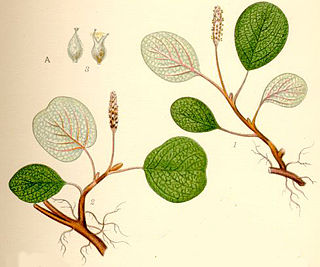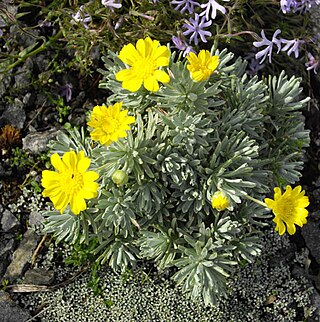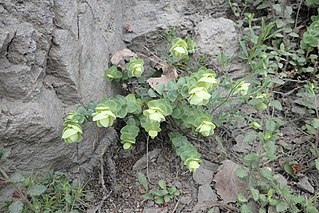
Tilia platyphyllos, the large-leaved lime or large-leaved linden, is a species of flowering plant in the family Malvaceae (Tiliaceae). It is a deciduous tree, native to much of Europe, including locally in southwestern Great Britain, growing on lime-rich soils. The common names largeleaf linden and large-leaved linden are in standard use throughout the English-speaking world except in the British Isles, where it is known as large-leaved lime. The name "lime", possibly a corruption of "line" originally from "lind", has been in use for centuries and also attaches to other species of Tilia. It is not, however, closely related to the lime fruit tree, a species of citrus.

Scilla siberica, the Siberian squill or wood squill, is a species of flowering plant in the family Asparagaceae, native to southwestern Russia, the Caucasus, and Turkey. Despite its name, it is not native to Siberia.

Erica vagans, the Cornish heath or wandering heath, is a species of flowering plant in the family Ericaceae, native to Ireland, Cornwall, western France and Spain. It is a vigorous, spreading, evergreen heather reaching 75 cm (30 in) tall and wide, with pink flowers borne in racemes 14 cm (6 in) long in summer and autumn. The Latin specific epithet vagans literally means "wandering"; in this context it means "widely distributed".

Salix reticulata, the net-leaved willow, or snow willow, is a dwarf willow, native to the colder parts of Europe, North America, and Northern Asia. It is found in the western United States, including the Sierra Nevada and Rocky Mountains. In Europe it extends south through the Carpathian Mountains and Alps to the Pyrenees and the mountains of Bulgaria and North Macedonia. It is common in Canada, Greenland and Finland, and present but rare in Scotland.

Kalmia angustifolia is a flowering shrub in the family Ericaceae, commonly known as sheep laurel. It is distributed in eastern North America from Ontario and Quebec south to Virginia. It grows commonly in dry habitats in the boreal forest, and may become dominant over large areas after fire or logging. Like many plant species of infertile habitats it has evergreen leaves and mycorrhizal associations with fungi. It is also found in drier areas of peat bogs.

Ligustrum ovalifolium, also known as Korean privet, California privet, garden privet, and oval-leaved privet, is a species of flowering plant in the olive family Oleaceae. The species is native to Japan and Korea.

Euryops pectinatus, the grey-leaved euryops, is a species of flowering plant in the family Asteraceae, endemic to rocky, sandstone slopes in the Western Cape of South Africa.

Oscularia deltoides, the deltoid-leaved dewplant, dassievygie or sandsteenvygie is a species of flowering succulent plant in the fig-marigold family Aizoaceae that is native to the south-western Cape, South Africa.

Lewisia cotyledon is a species of flowering plant in the family Montiaceae known by the common names Siskiyou lewisia and cliff maids. It is native to southern Oregon and northern California, where it grows in rocky subalpine mountain habitat.

Salix acutifolia, also known as Siberian violet-willow, long-leaved violet willow or sharp-leaf willow, is a species of flowering plant in the family Salicaceae, native to Russia and eastern Asia. It is a spreading, deciduous shrub or tree, growing to 10 m (33 ft) tall by 12 m (39 ft) wide. The young shoots are deep purple with a white bloom. The leaves are narrow, up to 10 cm (4 in) long. The catkins are produced in early spring, before the leaves. Older bark has a fine, netted pattern.

Sedum spathulifolium is a species of flowering plant in the family Crassulaceae known by the common names broadleaf stonecrop, yellow stonecrop, and spoon-leaved stonecrop. An evergreen perennial, it is native to western North America from British Columbia to southern California, where it can be found often in shade in many types of rocky habitat in coastal and inland hills and mountains.

Iris lutescens, the Crimean iris, is a rhizomatous flowering plant in the genus Iris. It is native to North East Spain, Southern France and Italy. It is found on rocky or sandy hillsides or in woodlands.

Euryops acraeus, the mountain euryops, is a species of flowering plant in the daisy family Asteraceae, native to the Drakensberg Mountains of South Africa. It is a dwarf, rounded evergreen shrub growing to 30 cm (12 in) tall and wide, with silver-blue leaves and masses of yellow composite flowers in spring and summer.

Globularia cordifolia, the heart-leaved globe daisy, is a species of flowering plant in the family Plantaginaceae, native to the mountains of central and southern Europe, and western Turkey.

Helleborus argutifolius, the holly-leaved hellebore, or Corsican hellebore, syn. H. corsicus, H. lividus subsp. corsicus is a species of flowering plant in the family Ranunculaceae, native to Corsica and Sardinia. It is an evergreen perennial growing to 120 cm (47 in) tall by 90 cm (3 ft) wide, with large leathery leaves comprising three spiny-toothed leaflets, and green bowl-shaped flowers in late winter and early spring.

Itea ilicifolia, the holly-leaved sweet spire, is a species of flowering plant in the family Iteaceae, native to western China. It is an evergreen shrub growing to 3–5 m (10–16 ft) tall by 3 m (10 ft) broad, with glossy holly-like leaves and fragrant drooping racemes of greenish-white flowers, 30 cm (12 in) long, in summer and autumn. It is hardy, though young plants require protection from dry winds.

Origanum rotundifolium, the round-leaved oregano, is a species of flowering plant in the family Lamiaceae, native to Turkey, Armenia and Georgia. It is a small woody-based perennial or subshrub growing to 10–30 cm (4–12 in) tall by 30 cm (12 in) wide, with strongly aromatic leaves, and loose clusters of pink flowers with hop-like pale green bracts, throughout the summer.

Phlomis chrysophylla, the golden-leaved Jerusalem sage, is a species of flowering plant in the family Lamiaceae, native to southwest Asia. It is an evergreen shrub growing to 1 m (3 ft) tall by 1.2 m (4 ft) wide, with woolly-textured, sage-like leaves that turn lime green with age, and yellow flowers carried in the leaf axils in early summer.

Thymus pulegioides, common names broad-leaved thyme or lemon thyme, is a species of flowering plant in the family Lamiaceae, native to Europe. Growing to 5–25 cm (2–10 in) tall by 25 cm (10 in) wide, it is a small spreading subshrub with strongly aromatic leaves, and lilac pink flowers in early summer. The specific epithet pulegioides highlights its similarity to another species within Lamiaceae, Mentha pulegium (pennyroyal).

Viburnum cinnamomifolium, the cinnamon-leaved viburnum, is a species of flowering plant in the family Adoxaceae, native to western China. Growing to 5 m (16 ft) tall and broad, it is a substantial evergreen shrub with large, triple-veined, glossy, oval leaves up to 15 cm (6 in) long. Round clusters of tiny white flowers are produced in late spring, followed in late summer and autumn by oval black fruits.




















